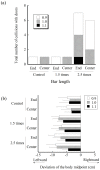Rule for scaling shoulder rotation angles while walking through apertures
- PMID: 23144736
- PMCID: PMC3483222
- DOI: 10.1371/journal.pone.0048123
Rule for scaling shoulder rotation angles while walking through apertures
Abstract
Background: When an individual is trying to fit into a narrow aperture, the amplitude of shoulder rotations in the yaw dimension is well proportioned to the relative aperture width to body width (referred to as the critical ratio value). Based on this fact, it is generally considered that the central nervous system (CNS) determines the amplitudes of shoulder rotations in response to the ratio value. The present study was designed to determine whether the CNS follows another rule in which a minimal spatial margin is created at the aperture passage; this rule is beneficial particularly when spatial requirements for passage (i.e., the minimum passable width) become wider than the body with an external object.
Methodology/principal findings: Eight young participants walked through narrow apertures of three widths (ratio value = 0.9, 1.0, and 1.1) while holding one of three horizontal bars (short, 1.5 and 2.5 times the body width). The results showed that the amplitude of rotation angles became smaller for the respective ratio value as the bar increased in length. This was clearly inconsistent with the general hypothesis that predicted the same rotation angles for the same ratio value. Instead, the results were better explained with a new hypothesis which predicted that a smaller rotation angle was sufficient to produce a constant spatial margin as the bar-length increased in length.
Conclusion: The results show that, at least under safe circumstances, the CNS is likely to determine the amplitudes of shoulder rotations to ensure the minimal spatial margin being created at one side of the body at the time of crossing. This was new in that the aperture width subtracted from the width of the body (plus object) was taken into account for the visuomotor control of locomotion through apertures.
Conflict of interest statement
Figures






Similar articles
-
Walking through an aperture with visual information obtained at a distance.Exp Brain Res. 2017 Jan;235(1):219-230. doi: 10.1007/s00221-016-4781-7. Epub 2016 Sep 29. Exp Brain Res. 2017. PMID: 27687556
-
Locomotion through apertures when wider space for locomotion is necessary: adaptation to artificially altered bodily states.Exp Brain Res. 2006 Oct;175(1):50-9. doi: 10.1007/s00221-006-0525-4. Epub 2006 Jun 8. Exp Brain Res. 2006. PMID: 16761139
-
Sensory substitution information informs locomotor adjustments when walking through apertures.Exp Brain Res. 2014 Mar;232(3):975-84. doi: 10.1007/s00221-013-3809-5. Epub 2013 Dec 27. Exp Brain Res. 2014. PMID: 24370580
-
Action strategies for walking through multiple, misaligned apertures.Acta Psychol (Amst). 2018 Jan;182:100-106. doi: 10.1016/j.actpsy.2017.11.006. Epub 2017 Nov 20. Acta Psychol (Amst). 2018. PMID: 29156367
-
Action strategies of individuals during aperture crossing in nonconfined space.Q J Exp Psychol (Hove). 2013 Jun;66(6):1104-12. doi: 10.1080/17470218.2012.730532. Q J Exp Psychol (Hove). 2013. PMID: 23718874
Cited by
-
Walking through Apertures in Individuals with Stroke.PLoS One. 2017 Jan 19;12(1):e0170119. doi: 10.1371/journal.pone.0170119. eCollection 2017. PLoS One. 2017. PMID: 28103299 Free PMC article.
-
Haptic feedback intervention decreases the spatial margin when older adults walk through a narrow space.J Physiol Anthropol. 2022 Dec 13;41(1):41. doi: 10.1186/s40101-022-00315-y. J Physiol Anthropol. 2022. PMID: 36514087 Free PMC article.
-
Walking through an aperture with visual information obtained at a distance.Exp Brain Res. 2017 Jan;235(1):219-230. doi: 10.1007/s00221-016-4781-7. Epub 2016 Sep 29. Exp Brain Res. 2017. PMID: 27687556
-
Improved Walking Through an Aperture in a Virtual Environment Transfers to a Real Environment: Introduction of Enriched Feedback and Gradual Increase in Task Difficulty.Front Sports Act Living. 2022 Mar 4;4:844436. doi: 10.3389/fspor.2022.844436. eCollection 2022. Front Sports Act Living. 2022. PMID: 35308597 Free PMC article.
-
Influencing the body schema through the feeling of satiety.Sci Rep. 2022 Feb 11;12(1):2350. doi: 10.1038/s41598-022-06331-3. Sci Rep. 2022. PMID: 35149735 Free PMC article.
References
-
- Warren WHJ, Whang S (1987) Visual guidance of walking through apertures: body-scaled information for affordances. J Exp Psychol Hum Percept Perform 13: 371–383. - PubMed
-
- Higuchi T, Cinelli ME, Greig MA, Patla AE (2006) Locomotion through apertures when wider space for locomotion is necessary: adaptation to artificially altered bodily states. Exp Brain Res 175: 50–59. - PubMed
-
- Higuchi T, Hatano N, Soma K, Imanaka K (2009) Perception of spatial requirements for wheelchair locomotion in experienced users with tetraplegia. J Physiol Anthropol 28: 15–21. - PubMed
-
- Higuchi T, Murai G, Kijima A, Seya Y, Wagman JB, et al. (2011) Athletic experience influences shoulder rotations when running through apertures. Hum Mov Sci 30: 534–549. - PubMed
-
- Wagman JB, Malek EA (2007) Perception of whether an object can be carried through an aperture depends on anticipated speed. Exp Psychol 54: 54–61. - PubMed
Publication types
MeSH terms
LinkOut - more resources
Full Text Sources

